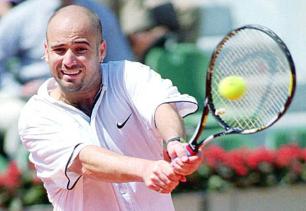A good tennis player must have the ability to use tennis singles strategy limit the options for his opponents making him uncomfortable. The winner of any tennis match is usually the one who can make his opponent uncomfortable and keep him there throughout the match.
There are some basic points for a good tennis player when it comes to tennis singles strategy. Singles is a game played one on one, and there will be very little help from anyone but yourself. It is important to develop sound tennis singles strategy in order to become a smarter player on the tennis court.
A Common Scenario for Tennis Players
How often has this scenario occurred. In the warm-up, prior to a competitive tennis match you notice that your opponent is a “worse player” with “bad or ugly” tennis strokes. But often times, these club hackers or inept counter punchers are deceptive and have a uncanny ability to maneuver the tennis ball according to their tennis singles strategy, causing you to be on the defensive. The end result is often a win for them, and a loss for you. Logically, you should have won this match, but clearly your opponent outplayed you with a wise mix of tennis singles strategy.
These principles of tennis singles strategy can make a big difference for you as a tennis player. Developing proper tennis strokes is only one part of the recipe needed to be a successful tennis player. The other part is being smarter on the tennis court and understanding the key principles of tennis singles strategy. Developing strategy comes from awareness followed by execution.
High Percentage Tennis Singles Strategies
Any good tennis singles strategy will be based on high percentage tennis where you have the highest chance of making the shot with the least amount of risk. This is often why lower level players can beat players with better strokes, only because they have learned to develop high percentage plays based around the laws of physics and gravity.
For example, the crosscourt rally shot is often the most critical because it allows for the longest distance court-wise, giving the ball additional space for margin of error. Also, a crosscourt shot passes over the shortest part of the net, so it is often considered one of the primary singles tennis strategy shots.
A good player always tries to hit to the left of the opponent, on right, over the head, at feet of him. These all points are necessary for basic tennis strategy. A player must have some knowledge about tennis strategy so that he can do a quick analysis of his own game as well as observation on his opponents’ weakness.
Tennis Singles Strategy #1
There are some fundamental aspects of tennis strategy that a player must have full command on every shot: crosscourt, deep, and down the line. Advanced tennis players that follows this rule will have the opportunity to attack the net once the opponent is put into a defensive position. Keenness is an essential element for the development of a tennis player.
Tennis Singles Strategy #2
An experienced player will try to reduce the errors and keep his eyes to win the match as it is a rule of tennis strategy. When both players are equally matched, then to win the match the player who makes fewest unforced errors will dominate. More errors will increase the chance to lose the match; a clear percentage of errors will decide the winner of the tennis match. Reducing unforced error is a key rule for tennis singles strategy.
If a tennis player follows the tennis strategy of reducing their unforced errors, then they will donate fewer points to their opponents. And then the chance to win the match increases. Once fewer unforced errors are made on your own part, the opponent will be forced to hit better and riskier shots to win points.
Tennis Singles Strategy #3
It is very important to note that the pressures of tight match situations will rule on the player. Remember to stick to your tennis singles strategy and not let other outside thoughts interfere which will throw off the entire biomechanical stroke production. Players must remember to play the match more aggressively which will then lead to defensive short balls to attack.
Its important to define your game plan prior to the match and stick with it. Once the mind becomes confused. It is more likely to start choking. It means that player knew the exact shot but he failed to execute it due to tension in the game. Any good tennis player that follows the rule of tennis strategy knows that constant attack will be a necessary cause for his victory in the match.
Tennis Singles Strategy #4


When a player gets pulled widely off the baseline, this action forces two extremes. In hope of winning either he will either try to hit the ball or he will produce an error for his opponent. It is a rule of tennis strategy that a player should elevate his shot 10 to 12 feet higher than the net to quickly neutralize his or her position.
Its important to increase the topspin and loop of your shot, especially when you are under pressure.
Tennis Singles Strategy #5
If your opponent plays soft shots to throw off your rhythm, then a advanced player should prepare to play differently, this is also a very important tennis strategy. And it is not always necessary to play beautiful game for winning the match. A good player must utilize topspin, slices, deep hits and high balls to lose the counteract his opponent. And he must focus on his game and on each and every short of the opponent.
Pushers or dinkers can be a dread to play, and it’s tempting to bash the ball hard right back at them. But, simply hitting as hard as you can against a pusher is poor tennis singles strategy, as it will often result in an unforced error every time. Unfortunately, patience is key when playing a pusher and it might mean you will have to work the point harder before you receive a easy ball to put away.
Tennis Singles Strategy #6
It is also an important rule of the tennis strategy that if any player has a weak backhand and a great forehand then he must not let his opponent use his or her strength. He must anticipate the power and the direction of the next shot from the opponent and always play better than him. This may cause the increase in difficulty level of the game but it is necessary to win the match.
Focusing on making plays towards an opponent’s weakness is considered a sound singles tennis strategy. But how often do you consciously execute this tennis singles strategy? If the answer is rarely, then you may want to consider adding this one element to your repertoire.
Tennis Singles Strategy #7
Diagonal crosscourt forehands should be your primary asset in your tennis game. The crosscourt shot, whether it be forehand and backhand should be your bread and butter when it comes to tennis singles strategy.
Tennis Singles Strategy #8
An important tennis strategy is understanding this rule that you must play with confidence and avoid risky shots. It is very important to hit the right shot using high percentage plays at the right time.
Tennis Singles Strategy #9
Another tennis strategy is to develop a proper game plan for the tennis match ahead of time. Without a tennis singles plan, you will struggle and suddenly change your plan and movement during the match.
Tennis Singles Strategy #10
Here are some basics for very powerful tennis strategy.
Learn to Hit a Forehand Like Roger Federer
If you want to jumpstart your forehand and play like the PROS, check out my 70+ page Tennis Ebook that will immediately show you how you can take your forehand to the next level.
The Modern Forehand Domination Ebook is guaranteed to improve your tennis technique, and increase power, topspin and accuracy of your tennis forehand!
Modern Tennis Forehand Ebook
Learn How to Hit a Forehand Like Federer, Nadal and Djokovic

